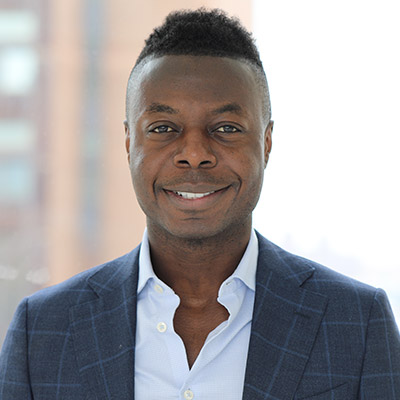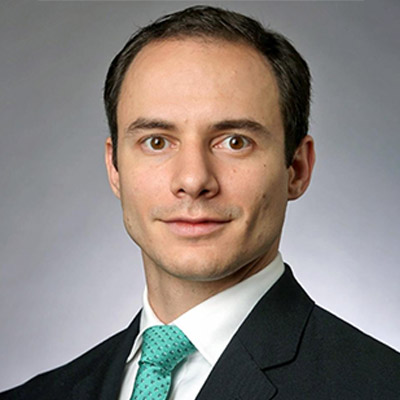Two orthopedic surgeons from NewYork-Presbyterian and Columbia, David P. Trofa, MD, and Nana Sarpong, MD, MBA, were recently named to Avant-garde Health’s 2024 Healthcare Research All-Stars, in recognition of the quality and quantity of the honorees’ research. As two of the 182 Orthopedic Research All-Stars, Drs. Trofa and Sarpong are pioneering the use of groundbreaking techniques in sports medicine and joint replacement, respectively.
Surgeons and hospitals who are recognized as Avant-garde Healthcare Research All-Stars are among the top 1% of those publishing leading-edge healthcare research. The awards criteria include procedural volumes, peer-reviewed publications, and publication weight.
The honor comes as something of a surprise to Drs. Trofa and Sarpong. “Pinpointing the top 1% of any field seems like an impossible task given the number of metrics that could be considered,” comments Dr. Trofa, who describes himself as “humbled to even be in the same conversation as my mentors” some of whom are among the most international renown sports surgeons in the country (for example Dr. William N. Levine, chairman of Columbia Orthopedics, and Dr. Christopher S. Ahmad, Chief of Sports Medicine and Head Team Physician of the New York Yankees).
Dr. Sarpong notes that the award will “give me more fuel for publishing with what we consider standard of care to help improve the lives of patients.”
Expediting Athletes’ Return to Play
For Dr. Trofa, an orthopedic sports medicine surgeon with expertise in arthroscopic and open surgery of the knee and shoulder, getting injured athletes back on the field at their pre-injury level is the main focus of his practice. Dr. Trofa has published over 140 peer-reviewed articles including:
- A 2020 randomized controlled trial in which a novel hybrid transtibial (HTT) drilling technique in anterior cruciate ligament (ACL) reconstruction was compared to more traditional drilling methods. The manuscript was awarded the Excellence in Research Awardby the American Orthopaedic Society for Sports Medicine (AOSSM). “I have performed ACL reconstructions utilizing the hybrid transtibial technique for the past five years with excellent outcomes,” he explains. “We continue to study the technique and hope to perform a randomized controlled trial of patient-reported outcomes and return to sport rates.”
- A 2023 systematic review and meta-analysis published in the American Journal of Sports Medicine (AJSM) showing equivalent outcomes for cartilage transplantations of the knee performed with osteochondral allografts (cadaver tissue) and autografts (tissue from the patient). As a result of this research Dr. Trofa states that he “has transitioned to utilizing mostly osteochondral allografts for cartilage transplantations to avoid taking cartilage plugs from a separate area of a patient’s knee.”
A 2024 retrospective review published in Arthroscopy that found favorable results for patients undergoing particulated juvenile articular cartilage allograft transplantation for patellofemoral articular cartilage defects.
Utilizing Advanced Technologies in Knee and Hip Arthroplasty
Dr. Sarpong is an orthopedic surgeon specializing in hip and knee reconstruction. Much of his research focuses on the use of robotic technologies to guide knee replacement surgeries. “With robotic guidance, we’re using a three-dimensional preoperative image in the form of a CT scan to landmark the patient’s anatomy,” he explains. “Even before we get into the operating room, we can plan the surgery and execute based on the patient’s soft tissue status, so as to achieve a knee replacement where the patient’s native anatomy is being considered. It’s a more soft tissue-friendly technology, allowing us to better quantify and objectify the knee replacement.”
He has published more than 80 peer-reviewed papers, textbook chapters, editorials, and national and international scientific presentations including:
- A study published in Arthroplasty Today in 2021 which described how robot-assisted total knee arthroplasty (TKA) resulted in improved intraoperative compartment balancing in flexion with no observed difference in mid-flexion and extension, compared with conventional jig-based instrumentation.
- A cohort study published in Surgical Technology International (STI) in 2022 that reported that robot-assisted TKA yields a high repeatability of registration of anatomic landmarks and gap assessment for both image-based and image-free software.
- A study published in STI in 2023 that found that robotic TKA leads to improvement in postoperative flexion and range of motion (ROM), compared to preoperative ROM, at two-week follow-up, a finding that may explain the quicker recovery associated with robotic TKA.
Dr. Sarpong has also published extensively in hip arthroplasty, which comprises roughly one-third of his practice.
Leveraging In-house Resources and Expertise
Both Drs. Trofa and Sarpong both credit NewYork-Presbyterian and Columbia for providing an environment that is conducive to advancing cutting-edge research. “The collaborative environment at NewYork-Presbyterian and Columbia has been key to my academic success,” Dr. Trofa continues. “I have been blessed with outstanding mentors like Drs. Levine and Ahmad who not only taught me the intricacies of arthroscopic surgery while I was a resident, but how to perform clinical research and build a multidisciplinary team to help answer important questions that could improve patient outcomes.” Part of that team includes Professor Clark T. Hung in the Biomedical Engineering Department at Columbia, whose expertise in cartilage restoration assisted Dr. Trofa in obtaining a grant from the Arthroscopy Association of North America (AANA) to evaluate chondrocyte viability in allograft transplantations.
The collaborative environment at NewYork-Presbyterian and Columbia has been key to my academic success.
— Dr. David Trofa
“One of the benefits of being at NewYork-Presbyterian and Columbia is that we get to treat and take care of patients from all walks of life,” echoes Dr. Sarpong, whose current primary research interest is the use of technology to advance health equity. “The fact that we are located at a place with a huge catchment area that affords us access to patients from diverse backgrounds allows us to study not just one subset of the population, but multiple subsets. That will allow good external validity when we apply our findings to the population. Other institutions can look at our studies and say they make sense because we studied different types of people.”
The fact that we are located at a place with a huge catchment area that affords us access to patients from diverse backgrounds allows us to study not just one subset of the population, but multiple subsets. That will allow good external validity when we apply our findings to the population.
— Dr. Nana Sarpong




